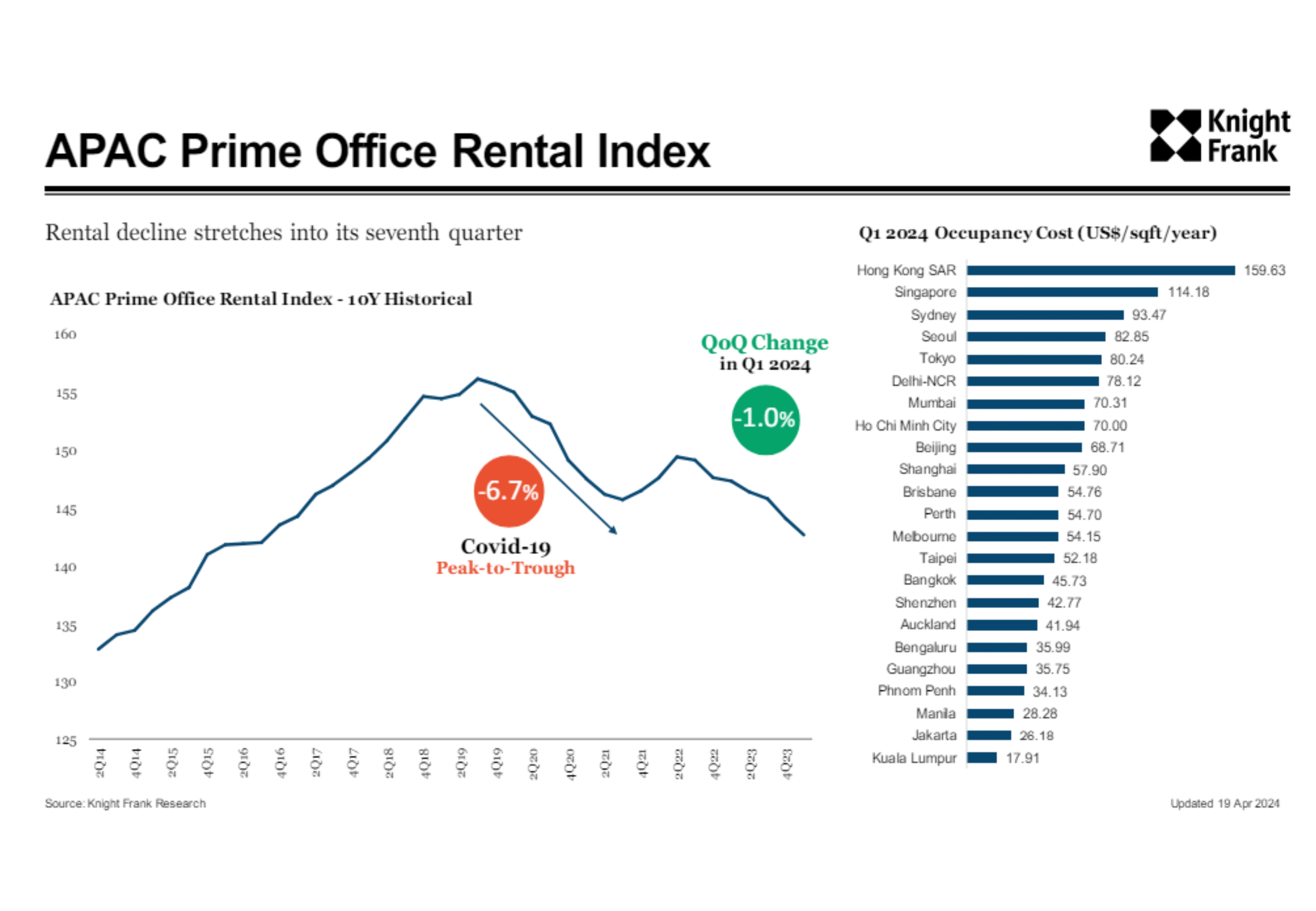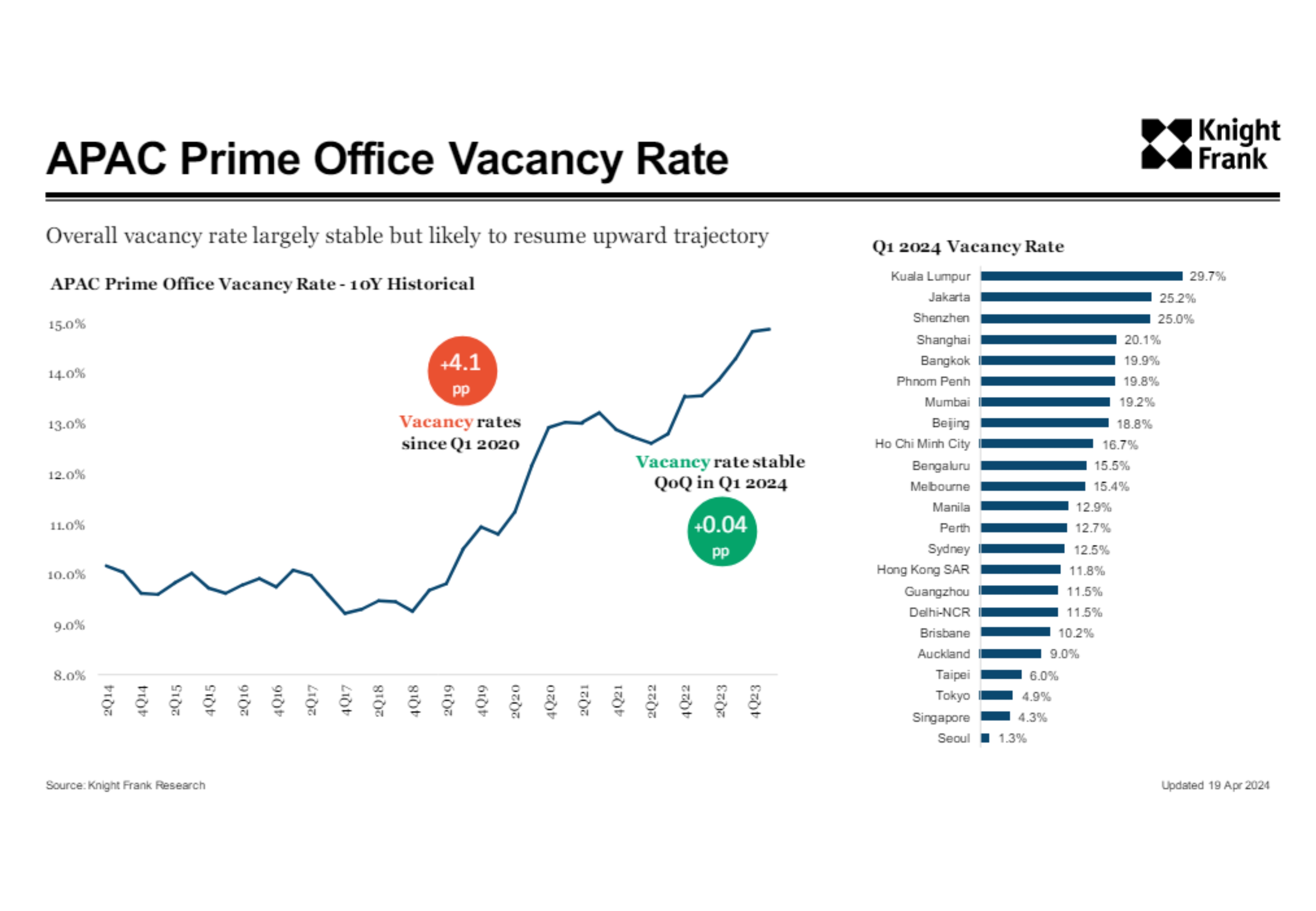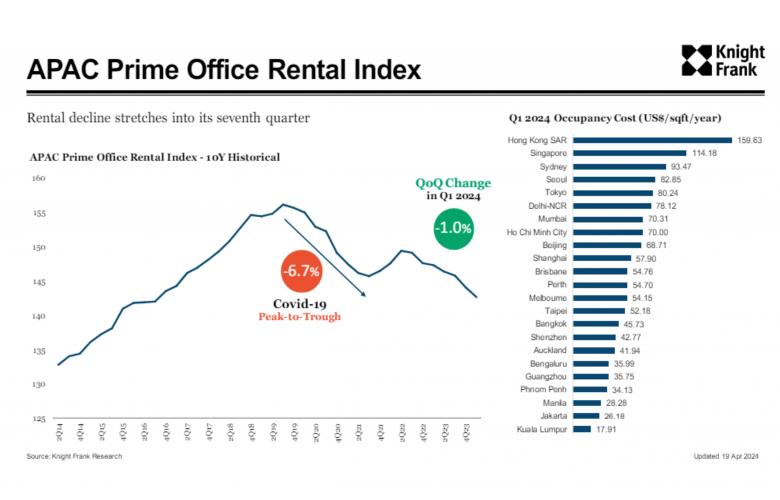Knight Frank, the independent global property consultancy, has released its latest Asia-Pacific Prime Office Rental Index for Q1 2024, which showed a continued downward trajectory for the region. The index registered a 3.2% year-on-year decline, steeper than the 2.4% year-on-year fall in Q4 2023. This seventh consecutive quarterly drop was primarily driven by deepening rental declines in Chinese Mainland cities, which reached record lows during the quarter.
However, the regional rental prime office landscape exhibited contrasting extremes. While Chinese Mainland cities struggled with weak fundamentals, cities such as Seoul and Taipei experienced multi-year high rental rates, reflecting a flight-to-quality trend favouring prime office assets in these markets.
Highlights for Q1 2024:
- 15 out of 23 cities tracked by the index recorded stable or increased rents in Q1 2024, compared with 13 cities in Q4 2023
- Brisbane led rental growth at 6.8% YoY
- The Asia-Pacific prime office market will continue to favour tenants in 2024, with vacancy rates expected to trend upward

Positive trends in select markets with regional vacancy rates at record highs
According to the report, while Ho Chi Minh City and Phnom Penh have halted their declines, the current upward trend may face challenges due to the substantial construction pipeline in these markets. Additionally, regional vacancy rates have reached record highs, reflecting the ongoing growth in office space supply.
The prime office market in Singapore remained resilient, with a slight 0.6% quarter-on-quarter increase, supported by positive rental reversions. However, the upward trend shows signs of waning and could stabilise in the second half of 2024 as the technology and financial sectors undergo restructuring.
Regionwide vacancies rose again marginally to 14.9%, which sustained a trend that has seen the metric continually breach record highs since Q4 2022.

Tim Armstrong, global head of occupier strategy and solutions, said, "Although the region remains largely caught in a tenant-favourable setting, the bifurcation in metrics between the top and the lower rated assets indicates diverging conditions between these segments. A consistent theme across the region is the strength of demand for spaces at the higher end. These conditions were particularly acute in cities in Australia and New Zealand but also observed in Japan's capital, Tokyo, and Southeast Asia’s emerging markets. Although weaker in Chinese Mainland markets, we expect this recurring flight-to-quality theme to intensify as occupiers seek quality assets to optimise portfolios, experiment and evolve their hybrid work plans and hit ESG targets. As momentum builds around portfolio dynamics, shifting from strategy to execution, occupiers will continue to align capex constraints with commercial real estate strategy."
Meanwhile, occupiers in the region are signaling a stronger return to the office. The latest Knight Frank Corporate Real Estate Sentiment Index registered significant gains in sentiment around a return to pre-pandemic occupancy levels. Going forward, the interplay between a greater return to office and a more densely occupied office will be a key theme.
Christine Li, head of research, Asia-Pacific, said, "Against a backdrop of capex constraints and lower headcount growth, overall vacancies will likely remain elevated for the rest of 2024, as occupiers will continue to prioritise lease renewals and remain selective in expansionary plans. However, there remain pockets of strength within the region, supported by occupiers' long-term strategic interest in the region's superior economic growth, growing consumer markets, and skilled workforce. We expect offshoring firms in India and Philippines to remain a pillar of demand while portfolio optimisation will continue to propel absorption of prime spaces in the developed markets."

Teh Young Khean, Executive Director of Knight Frank Malaysia's Office Strategy & Solutions said, “Kuala Lumpur has positively registered a decrease in prime office vacancy levels from 31.3% in Q4 2023, down to 29.7% in Q1 2024. This is due to occupiers moving into almost 600,000 square feet of prime office space in this quarter, reinforcing the flight-to-quality and flight-to-green trend.”
“Rent-wise, we observe a modest annual change in prime office rental rates with a 3.0% increase year-on-year and a slight quarterly change of 0.3%. Looking ahead, our forecast suggests that rental rates in Kuala Lumpur are likely to remain stable over the next 12 months. This stability indicates resilience in the market amidst broader regional trends.
Kuala Lumpur prime offices continue to have the lowest occupancy cost in Asia Pacific, reinforcing our attractiveness as a key location within Asia Pacific’s offshoring market,” added Teh.
For further information, please contact Tim Armstrong, global Head of Occupier Strategy and Solutions, Knight Frank, Christine Li, Head of Research, Knight Frank Asia-Pacific, and Teh Young Khean, Executive Director of Knight Frank Malaysia's Office Strategy & Solutions as the details below.













